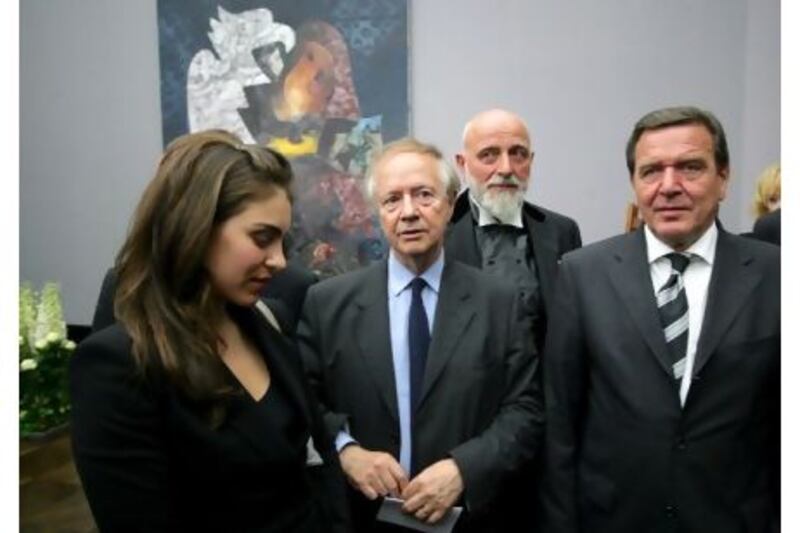BERLIN // The international art world has been shaken by a major fraud case in Germany involving the forgery of up to 50 paintings attributed to 20th-century artists that were sold to galleries and collectors around the world.
Two men and two women are to stand trial later this summer in Cologne accused of forging work by painters including Max Ernst, Max Pechstein, Fernand Léger and Heinrich Campendonk, in what experts are calling Germany's biggest art scandal since the Second World War.
Some of the paintings changed hands for millions of euros.
The case has exposed the gullibility of auction houses, collectors and art experts, especially in the market for classical modern art, which is currently in vogue and enjoying soaring demand. Auctioneers who handled the paintings face accusations that they had neglected to conduct proper checks because they were eager to go ahead with lucrative sales.
The Cologne state prosecutor's office said last month it was charging the alleged forger, Wolfgang Beltracchi, 60, his wife, sister-in-law and a male accomplice with fraud for the sale of 14 fake paintings causing total losses to buyers estimated at €34.1 million (Dh178.2m). Investigations are continuing into the sale of 33 further works believed to be forged, the office said.
One of the paintings is reported to have been bought by Steve Martin, the US entertainer, who later sold it via Christie's. Another of the works, "La Foret (2)" by Max Ernst, was sold for $7 million (Dh25.7) to Daniel Filipacchi, a French media mogul, at an art auction in Paris in 2006.
The forgeries were good enough to prompt Werner Spies, a German art historian regarded as a world authority on Ernst, to declare at least five of the Ernst fakes to be genuine.
Mr Spies is being sued for damages in France by Monte Carlo Art for having authenticated a fake Ernst, Tremblement de Terre, in 2004.
Mr Spies told the Frankfurter Allgemeine Zeitung, a national daily, last week that he "had no doubts for a moment" that the Ernst works he had inspected were genuine. He said he had regarded the discovery of paintings that he had not seen before as "a stroke of luck".
Three of the defendants, including Mr Beltracchi, a trained artist, have been in custody since last August pending the investigation. They had allegedly been selling forgeries since the mid-1990s, claiming that the paintings all came from a collection amassed by Werner Jägers, a wealthy entrepreneur who died in 1992 and who was the grandfather of Mr Beltracchi's wife and her sister.
They told buyers that Mr Jägers had bought the paintings from a well-known Jewish art dealer, Alfred Flechtheim, who fled Germany when the Nazis came to power in 1933. It is now known that Mr Jägers did not in fact collect art.
The gang had succeeded in gaining the trust of the auctioneers they took the paintings to. "They made a good impression," Henrik Hanstein, the owner of Lempertz, a Cologne auction house, told Art, a German trade magazine.
The forgers had been helped by the fact that many 20th-century works, though registered as having been painted by the artists, had gone missing during the Third Reich. The Nazis labelled all modern art as "degenerate", closed the galleries displaying such works and ostracised and persecuted the artists.
The scam worked for over a decade, and no one began suspecting anything was wrong until a trading company based in Malta, Trasteco, got doubts about a painting it had acquired for €2.4m at a Lempertz auction in late 2006 - Red Picture With Horses by Heinrich Campendonk, supposedly dating from 1914.
Ralph Jentsch, an art expert called in to appraise the painting, noticed that the "Flechtheim Gallery" label on the back of it looked so amateurish that the painting had to be a fake. He said the portrait of Flechtheim on the sticker looked like "a Beagle Boy from a Walt Disney comic or an anti-Semitic caricature". An aesthete such as Alfred Flechtheim would never have allowed himself to be depicted in this way, said Mr Jentsch.
The forgery was proved when scientific tests detected that titanium white pigment had been used in the painting - a pigment that did not exist in Campendonk's day.
The scandal has shaken faith in the auction houses that bring works onto the market, and the experts who deem them authentic. It has exposed how some auctioneers evidently refrain from full checks because they are in a hurry to conduct the sales, or because they have placed too much faith in the sellers.
Auctioneers and galleries now face a number of compensation lawsuits, but it is unclear whether buyers will be able to get all their money back - many auction houses have small print in their sales contracts that limits their liability.






